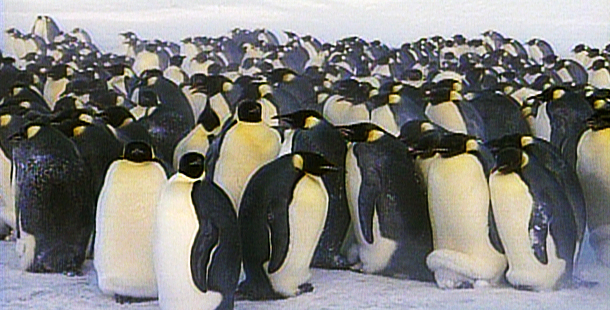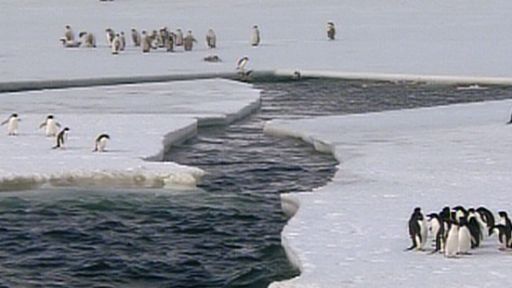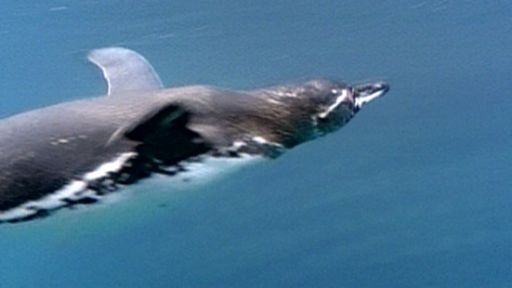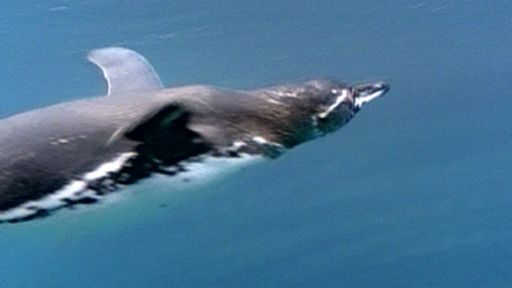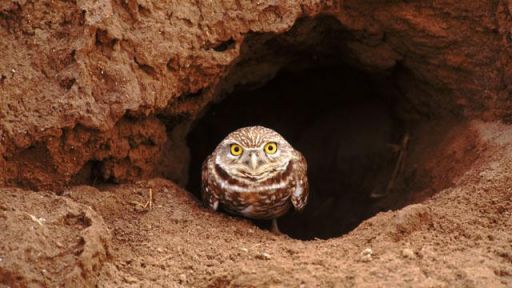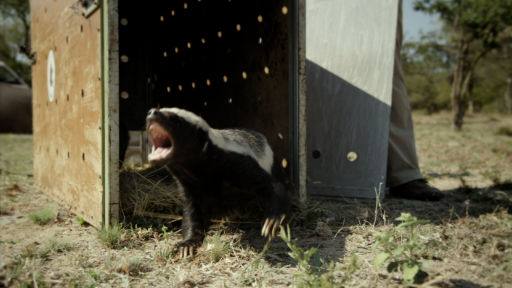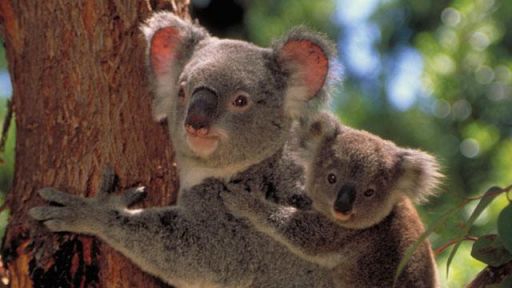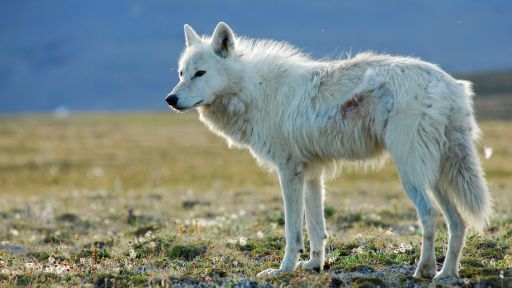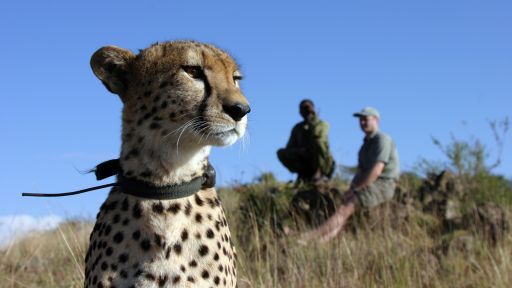TRANSCRIPT
[playful music] - [George] Penguins are not your your usual bird.
[penguins chirping] They have wings, but they can't fly.
On land, they may be clumsy, but at sea they're acrobats.
[water splashing] They have charm character and they wear a coat and tails.
The popular image of penguins is that of an awkward bird living in a world of ice and snow, but their story is not so black and white.
They can also be found in the scorching deserts of South America, the forests of New Zealand and even on suburban streets.
And their ability to survive under some of the toughest conditions on earth is anything but awkward.
Join us as we meet the real penguins.
[surf roaring] [bird cawing] [bright music] - [Announcer] This program was made possible by contributions to your PBS station from viewers like you.
Thank you.
- [George] We all have an image of penguins skating on ice at the South Pole.
Images that come from childhood.
[soft music] Penguins are storybook creatures to most of us, comical characters with a funny walk.
[children laughing] Real penguins are creatures of water.
They spend most of their lives at sea where they are fast and powerful predators.
[water splashing] They are awkward on land, even funny but penguins must live in two words and it's only their remarkable abilities that let them conquer both.
[penguins calling] [mystical music] Many think penguins live only in Antarctica.
[wind blowing] Four species come ashore there where it can reach a hundred degrees below zero.
But others are equally at home at a hundred degrees above.
[penguins calling] Some form vast colonies, others prefer to be alone.
The smallest penguins in the world may even come ashore.
In seaside suburbia.
[penguins chirping] They can be aggressive competitors or tender and dedicated partners.
Penguins originated more than 50 million years ago in the New Zealand region.
They were latecomers in the long history of birds.
The southern continents were splitting apart opening up new channels.
A circumpolar current brought rich nutrients to the newly formed southern oceans.
There were seabirds of many kinds along these ancient shorelines.
[birds squawking] Their wings carried them out to feed on the bounty of fish in the new currents But down on the shore, one group of seabirds gave up its ability to fly.
These birds used their wings to swim in the sea rather than fly above it.
It was a radical change of tactics in the evolutionary race.
Seabird of the air could quickly locate the teaming, gleaming shows of fish.
[soothing music] [birds cawing] But much of this food lay beyond the reach of these birds.
They could only scratch the surface.
Some birds, like petrels and albatrosses, learn to use their wings to chase prey underwater, but they could only dip into the first few feet of ocean.
[birds squawking] Wings designed for air don't work very well in water.
They're a compromise.
Penguins made no such compromise.
By totally giving up the ability to fly, their wings became powerful flippers.
[mystical music] They broke the dive barrier and were able to hunt prey at ocean depths where no other bird could go.
Penguins were so successful that they rapidly evolved into different types.
[penguins chirping] They now live all over the southern hemisphere.
The classic tuxedo types are found in Antarctica, along with the largest, like the emperors.
Six species with yellow crests and one with a yellow eye live on the islands across the sub Antarctic.
Little blues, the smallest penguins are found in New Zealand and southern Australia.
The northern most are the bandit penguins.
They live on the shores of southern Africa and South America.
And the farthest north of all live in the Galapagos Islands, straddling the equator.
There's enough food on the islands for grazers like marine iguanas and turtles.
But tropical waters are usually poor in nutrients and the great numbers of fish that penguins need, yet they flourish here.
These waters are special.
They are cold and nutrient rich and have come all the way from Antarctica via the Humboldt current.
The Galapagos islands abound with cold water animals like sea lions.
All penguins of the tropics and subtropics rely on cold rich currents to deliver silvery curtains of fish.
[soft music] A penguins have truly conquered the oceans.
They spend as much as 80% of their time in water.
Yet each year they forsake the sea and struggle ashore.
[water splashing] No matter how awkward it is, every penguin must return to land.
The two things which define them as birds, eggs and feathers, force them to live a life in two worlds.
[penguin honking] Birds lay eggs that can only be kept warm on land and worn out feathers must be replaced.
[water moving] This Galapagos penguin must wait high and dry until its plumage is waterproof again.
It was the variety of unusual creatures on the Galapagos islands that intrigued the great scientist Charles Darwin.
More than 150 years ago.
[mystical music] Darwin observed the different species of finch had beaks of different shape and function.
He also noticed that giant tortoises differed in size and patterning from island to island.
From these and other observations, Darwin theorized that species became suited to their environment.
Different environments eventually give rise to different species.
All penguins share a single environment, the sea.
That's what makes them all similar.
It's where they leave the water that makes them different.
[surf crashing] Craggy cliffs and angry seas, surely an impossible place for penguins to come ashore.
[waves crashing] [penguins chirping] As getting ashore is only half the battle.
There's still a 90 foot cliff to climb.
[waves crashing] They're called rockhopper penguins and it's easy to see why, they have extra strong ankles and long toenails to grip the wet boulders.
Their destination is a semi flat area at the top of the cliff where there's open space to nest.
Within the colony, each pair has its own nest site.
Ownership is loudly and sometimes painfully pointed out to each homecoming bird.
[penguins squawking] Apart from being at the top of the cliff the nests are unprotected.
While adults are safe up here, there are killers after their eggs.
[penguins squawking] Skuas, an attack at the center of a colony is met by a tight wall of angry beaks [penguins squawking] At the edge of the colony.
The nests are more exposed.
Skuas work in pairs.
[ominous music] One distracts the other waits for the right moment to strike.
[penguins squawking] Penguins that lose their eggs abandoned their nests.
This small colony will shrink, exposing even more eggs to the Skuas.
Before the season is over all the nests here will probably be empty.
[penguins chirping] Nearby, some rock hoppers have found a way to protect their eggs.
They nest among the colony of blue-eyed king cormorants.
The rock hoppers accept the cormorants as substitute penguins and together they form a larger, safer colony.
But avoiding predators is not always the critical factor in choosing a nesting site.
Some face a greater threat from the heat of the sun.
[waves crashing] On the other side of the Pacific, the surf pounds the east coast of New Zealand.
Here one of the rarest penguins in the world spends the summer in temperatures reaching 90 degrees.
All penguins are protected from the cold sea by a survival suit of feathers.
[water rushing] But their feathers don't change with the weather.
The warmer it gets the more they're in danger of overheating when they come ashore.
These penguins walk inland to find shelter from the heat.
For some, it's a slow waddling journey of up to a mile.
Yellow-eyed penguins are unique.
Unlike others, they seek solitary nest sites.
[water lightly splashing] [birds chirping] Looking for privacy, they seek the welcoming shelter of a cool coastal forest to nest in the shade of overhanging bushes and trees.
Suitable sites are usually far apart, so pairs don't nest within sight of each other.
They're not fond of crowds, but yellow eye pairs are devoted to each other and to their nests.
This need for seclusion has made them vulnerable.
Their cool forest homes are disappearing.
[fire raging] Most of New Zealand's native coastal forest has been cleared.
Today, Yellow eyed penguins come ashore to find a shocking change.
[penguins chirping] Their breeding areas have been turned into pasture for grazing sheep.
[sheep bleating] The penguins have been forced to nest in the open.
In 40 years, more than three quarters of the nesting pairs have disappeared from New Zealand.
Fewer than 2000 survive.
The yellow is one of the most endangered penguins in the world.
[Asian inspired music] Closer to the equator, on the coasts of Peru and Chile the sun beats down on a desert landscape.
Yet even here there are penguins.
Humboldt penguins have bare patches on their faces to help excess heat escape from their bodies.
In this land without trees there are only two ways to avoid the midday heat which can exceed 100 degrees.
You can leave very early in the morning and go fishing in the cool sea.
[surf roaring] [birds cawing] Or if you must stay behind to care for eggs you need a cool burrow dug into the cliff face.
For Humboldt penguins ashore the days pass like a long siesta.
[waves crashing] And those at sea are in no hurry to return.
They're content to drift in large rafts waiting until the cool of evening before stepping back on land.
Another penguin steps out to more of a nightlife.
[siren blaring] In New Zealand and South Australia.
The world's smallest penguins call little blues or fairy penguins come ashore only when it's completely dark.
[waves crashing] Where they choose to land is often close to us and the hazards we impose.
[horn honking] They prefer caves and burrows for nest sites but they're not all that choosy about the neighborhood.
[playful music] [dog barking] And they don't mind sharing with the people upstairs.
[siren blaring] To prepare for breeding, little blues began with extensive housework.
They reexcavate burrows, tidy nests and reacquaint themselves with their partners.
[penguin singing] - They sing nightly love songs which often keep the neighbors awake.
- [Man] Quiet!
- [George] Little blues have adjusted to modern inconveniences but some penguins need places that never seem to change.
Snares Island south of New Zealand is so remote.
It remains untouched by the outside world.
A society of snares crested penguins continues their traditional way of life here undisturbed.
[soft music] They shelter in the strange twisted branches of tree sized daisies, bent and contorted by the ferocious winds that sweep the island.
Occasionally, one sits in the branches, as though for a moment it was just a bird in a tree.
When it's time to nest, the males begin in the usual way with a fight.
[penguins squawking] They're at it long before the females have arrived.
[bright music] In early spring the females are still at sea on the way back from winter feeding grounds.
[water splashing] Even as they scale the rocky slopes that lead to their colonies, the males are still disputing territory.
[penguins squawking] They're fighting for much more than a patch of mud.
The victors will also win the favors of the approaching females.
In contrast to the pandemonium among the males the females approached the moment of breeding with order and decorum.
Each one looks for a male with a good nest sight.
[penguins squawking] First arrival, ignore many puffed up chest before selecting their spouse of the season.
[penguins squawking] Then they celebrate their choice and seal the bond.
Fights are usually won by males with bigger bills.
These winners breed early and produce more chicks passing on the trait to their young.
So among Snares penguins, the male bills are about 20% larger than the females.
It's the most pronounced sex difference for any penguin.
[mystical music] Time for fighting is a luxury not all penguins can afford.
[water splashing] Adélie penguins arrive at Ross Island after a long migration among icebergs.
They may have traveled more than 3000 miles on this perilous journey.
More than a quarter of them don't make it.
[penguins cooing] Like waiters and a fluster, they scurry off to breeding colonies that will be snow free for only a short time.
Both males and females arrive together.
There's no time to lose.
So Adélies have evolved a strategy which enables them to breed both quickly and efficiently.
A newly returned male will gather stones to line last year's nest.
A good Adélie father is one capable of caring for eggs on his own for weeks if necessary.
To do this, he must now be at his portly best.
The females too, will return to their own nests, but if there's no one there they will quickly choose a new mate.
[penguin calling] What they look for in the new mail is a strong baritone voice.
[penguins calling] The bigger and fatter the male penguin, the deeper his call.
If she doesn't like what she hears she'll keep on searching.
[sad music] [penguin calling] The best singers find mates quickly, for in the race to complete the breeding cycle before winter, delay could mean death to the chicks.
Some males find a new partner too quickly.
A late returning female can find last year's mate sharing the nest with someone else, but not for long.
[penguins squawking] In Adélies, the females do the fighting, driving the interlopers away.
Once the eggs are laid the lower voiced males show their worth.
Their extra fat means they can go without food for the entire time the females are away at sea.
A male may starve for a month, first during courtship then up to three weeks of sitting on his eggs.
Males who are not fat enough simply can't do the job and will have to desert the eggs.
It's spring on the coast of Southern South America.
[waves crashing] These are Magellanic penguins named after the straits of Magellan.
[waves crashing] Instead of looking for a new mate, they too try to save time by sticking with a proven partner.
[penguin honking] They find each other by going back to last year's borough.
They navigate unerringly from far across the ocean to the right borough, above the right beach.
[penguins honking] Females arrive to find males already in residence and calling for them.
[penguin honking] Their donkey like bray has earned them the South American nickname of jackass penguins.
Each call is as distinct as a fingerprint.
It's how a female recognizes her mate.
Having reunited the pair renews their commitment to each other with an elaborate greeting which includes bill dueling.
[Asian inspired music] These displays are complex.
They stimulate, appease, and at the same time contain elements of aggression.
More importantly, by releasing hormones they help synchronize the breeding patterns of the two birds.
The ceremony continues with intimate dances.
[beaks clacking] [penguins honking] Those who found a partner turned their attention back to the borough, gathering grass to reline it.
The grass helps insulate the eggs from the cold damp earth.
The male works hard to furnish the nest before he departs.
[penguin honking] Unlike an Adélie male, he won't have to fast for a month.
The female will incubate the eggs first while he goes to sea.
[waves crashing] Maintaining a borough season after season makes the job easier for Magellanic penguins, but for some penguins, a permanent nest is just not possible.
Just north of the Antarctic circle where Gentoo penguin's nest, the tussock grass gets tramped and fouled forcing the colony to find new nest sites each year.
Yet, even without a permanent nest site partners remain faithful to each.
The nest is lined with tussock from some distance away and from what's left nearby.
[penguins squawking] For Gentoos, nest sites aren't used as meeting places at the beginning of the breeding season.
The birds remain here all year round.
There's plenty of food in the nearby coastal waters and they don't have to migrate during winter.
Homecoming birds return to their partners [waves crashing] and their nests every day of the year.
Each year, a pair becomes more and more practiced at working together and they can rear more chicks.
[penguins cooing] The strength of their bond is reinforced daily by elaborate and enthusiastic greetings.
[penguins squawking] When the chicks hatch all penguin parents have to face a new challenge.
The chicks are in one world, they're food in another.
Over the next two months, Gentoos will take turns at the nest.
And with food close by, they'll probably raise two healthy chicks.
[penguins cooing] In tougher places penguins have devised other means to ensure their survival.
[playful music] Farther south on the island of South Georgia Gentoos share their territory with much larger king penguins.
The breeding strategy of the kings is as distinct as their color.
They grow to about three feet high and weigh as much as three Gentoos.
[penguin honking] Even their chicks are large.
A breeding pear could never hope to raise two of these fluffy giants so they never attempted it.
Their breeding methods make the colonies of kings unlike those of any other penguin.
They're crowded like other colonies but what's unique is the ages of their offspring.
The bulge under this penguin indicates that an egg has already been laid.
They incubate the egg between their feet and their bellies so there's no need for a nest, but they do have territories and squabble constantly to defend their personal space.
[penguins squawking] Alongside birds with eggs are almost fully grown chicks.
In the same colony there are two different breeding cycles.
The big chicks belong to late breeders from last summer.
Soon they will fledge and go to sea.
Adults that have completed breeding then undergo the other business that ties penguins to the land, molting.
For three weeks, they must stay ashore as their old feathers grow out and new ones grow in.
The short feathers lock together tightly with microscopic hooks.
So penguins, wherever they live, can maintain the same body temperature in the sea as on the land.
As the first snows of winter arrive, late breeding kings leave the colony and depart for far away feeding grounds, leaving their late chicks completely on their own.
[waves crashing], Through the depths of the sub Antarctic winter, chicks wait for their parents return with only the fat around their bellies to sustain them.
[soft music] During this time, adults range for thousands of miles across the ocean searching for food.
A chick's fast may last five months.
Finally, in the spring, it's plump well fed parent returns.
[lively music] [penguin chirping] [waves crashing] The king penguin's breeding strategy is unusual but logical.
By raising two chicks over three years, they found a way to adapt their breeding to the availability of food.
[penguins chirping] There's only enough to feed one chick at a time so they only lay a single egg.
They've solved the problem of survival on limited means to the enormous success of the colony.
But there's a whole other group that has opted for a bizarre approach to chick raising.
The south island of New Zealand is not really cold but it's damp.
[water rushing] And nesting here are the northern most of the crested penguin species.
Fiordland crested penguins also find only enough fish to feed one chick, yet they always lay two eggs and a month later there are two healthy chicks, but one is little more than an insurance policy.
[penguins squawking] Unlike other penguins, where parents share feeding duties the female goes to sea and brings back food while the male stands guard.
[penguins chirping] But even a well coordinated effort by two parents can protect the chicks from cruel reality.
One won't survive.
[chick peeping] It's not predetermined.
There's no prejudice.
The female simply feeds the nearest begging mouth.
But the larger, first hatched chick usually pushes its young sibling out of the way.
Eventually, the smaller one will weaken and die.
Other penguins take this strange breeding strategy a step further.
Erect-crested penguins gather in large breeding colonies on a few islands south of New Zealand.
[mysterious music] Because of their isolation.
They're the least studied of all penguins and in some ways the most mysterious.
These birds also lay two eggs, but the first is very small and is often knocked out of the nest to become a meal for skuas.
This may seem to be a terrible waste but perhaps they can't switch off a genetic program which compels them to lay two eggs.
Even though each pair can only hope to raise one chick.
[penguins squawking] [chick chirping] [playful music] Starvation is seldom a problem in Antarctica where Adélie parents can often raise a pair of chicks in a season.
Once they're two to three weeks old they're so big that both parents need to commute constantly to and from the sea to feed them.
Adélies are the fastest growing penguins with appetites to match.
Now, they're old enough to spend the day gathered together in creshes.
[penguins chirping] In the race to fledge their chicks before the onset of winter, the parents can't afford to stop.
[water splashing] [mysterious music] And their duties can bring them in harm's way.
A leopard seal hunts the shore looking for penguins to eat.
[water splashing] To feed their chicks they run this deadly gauntlet twice a day.
[water splashing] [penguins chirping] Having evaded one hungry creature they come home to another.
As each adult approaches the creshe it calls the chick answers immediately and sprints towards its long awaited meal.
The begging is insistent, and if a parent has two chicks, it seems overwhelming.
In fact, it's a parental ploy to divide the food by making them run for it.
[penguins chirping] The chick that's fed first stops chasing so the less dominant one can feed too.
Chicks continue to grow at a tremendous rate and three weeks later, they are transformed.
The Adélies have done it.
The chicks are now ready to leave the colony.
[majestic music] Autumn doesn't signal the end of breeding for all penguins.
The freezing surface of the Antarctic sea marks just the beginning of the most fantastic penguin story of all.
Emperor Penguin, the world's largest.
They hunt to depths of 1000 feet, deeper than any other penguin.
[water splashing] Once ashore, however their behavior is even more extreme.
Many have just swum a thousand miles to get here.
Now they will battle polar winds which stream at up to 120 miles an hour.
Conditions that would kill most animals in minutes.
[wind blowing] Journeys end for this group is Cape Crozier on Ross Island, just 700 miles from the South Pole.
It is the most southern of their winter breeding sites.
[penguins cooing] They haven't seen their partners for months but there are no nest sites for a rendezvous here.
This ice was open ocean just a few weeks ago.
Sometimes they hear a familiar call in the crowd and may meet up with a previous partner, but emperors are not very faithful which can lead to misunderstandings.
Even their fights are conducted with imperial restraint.
They can't afford to waste energy or fat.
[penguins cooing] The rippling of chest blubber is a good sign.
Females are looking for a partner who's big and fat.
[wind blowing] For the emperors, it's especially important that a male has a fat belly now.
His next meal is likely to be more than three months away.
[penguins honking] Emperors have abandoned territories.
They tolerate touching each other so they can huddle together to keep warm in the coldest Antarctic blizzards.
[penguins cooing] An emperor female lays a single egg, which will be carried on the feet of her mate through the depths of winter.
And during all this time, he will be without food.
It's a task no other bird could accomplish.
And even among emperors the smallest males are unable to go the distance.
As winter approaches, the females leave for the nearest open water.
Several days march away.
They won't be back 'til spring.
[water splashing] [majestic music] Antarctica is the coldest place on earth relying only on their feathers, their fat and the warmth of their neighbors.
The males huddled together in total darkness.
In the unthinkable cold of minus 120 degrees these remarkable penguins maintain their eggs at the same temperature as our bodies.
[penguins chirping] The colony is in constant motion.
Birds exposed to the icy wind move to shelter in its lead.
Everyone takes their turn on the edge.
[bright music] Finally, brilliantly, the sun.
At first, for just a few minutes each day, but spring has arrived.
With the coming of the light come new responsibilities for the males.
It's three months since they last fed themselves, but now they are required to feed others.
[chick chirping] Astonishingly, a starving father at the end of his reserves can produce a special milk for his chick by breaking down his own body tissue.
[penguins cooing] And then like the cavalry, the plump females appear in the distance.
Just in the nick of time.
[penguins honking] Each is guided to her mate by following his answer to her call.
[penguins honking] Down to his last, the male will soon be able to refuel at sea.
But first, he transfers his precious cargo to the feet of his eager partner.
[penguins honking] Mission safely accomplished.
The chicks stay warm under their parents' brooding patch but they're not always safe.
Even the long fasting emperors have their limits.
They won't starve to death for their chicks.
If their partner is too late returning, they must look to their own survival and abandon their chick.
A female returning too late from the sea attempts in vain to brood a lifeless chick.
But most chicks grow rapidly to full size.
All they need is a little luck and a lot of food.
As spring advances, the ice will break up beneath the colony and the chicks will be abandoned to find their own way to sea.
[water splashing] This moment seems to come far too early though the sea is soon to be their home, their first encounter is a frightening one.
Some hitch a ride with a Adélie penguins on an ice flow.
They'll complete their development out on the shrinking pack ice.
[soft music] [water splashing] Their parents too have completed their annual appointment on land and now eagerly returned to their real home.
Finally, they can luxuriate in the domain that shaped them, where every penguin lives like an emperor, where real penguins belong.
[uplifting music]

